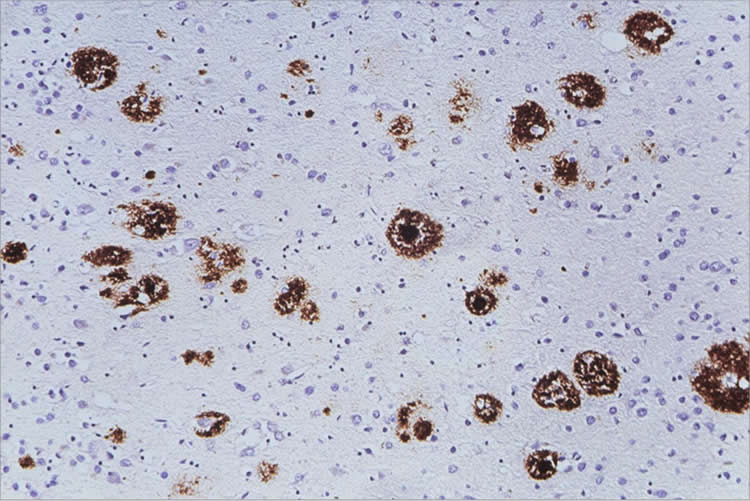Up to now Alzheimer’s disease has not been recognized as transmissible. Now researchers at the University of Zurich and the Medical University Vienna demonstrated Alzheimer-type pathology in brains of recipients of dura mater grafts who died later from Creutzfeldt-Jakob disease.
Alzheimer’s disease (AD) is characterized by progressive dementia and brain plaques consisting of the Aβ protein. Conventional wisdom has it that AD is not a transmissible disease. However, plaques recovered from brains of AD patients were repeatedly found to induce further plaques when injected into the brains of laboratory mice, suggesting that transmission may actually occur.
Reporting in today’s Swiss Medical Weekly, Karl Frontzek and colleagues (University of Zurich and Vienna Medical University) have investigated individuals who received brain grafts of dura mater during neurosurgery. The dura mater (“tough mother”) is the leathery membrane covering the brain and spinal cord. Such grafts were necessary to allow the brain to heal after surgery. Tragically, some of the dura mater donors were infected with prions (the agents causing the fatal Creutzfeldt-Jakob disease), and the grafting procedure transmitted the disease to the recipients.

Frontzek and colleagues now report the presence of Aβ plaques in 5 of 7 brains of relatively young recipients of dura mater grafts who succumbed to Creutzfeldt-Jakob disease. Aβ plaques were detected much more frequently than in brains of people who did not receive any dura mater grafts. Aβ plaques are highly unusual in young individuals and may have been caused by the dural grafts. This study adds to the evidence that the hallmarks of AD may indeed be transmissible under certain circumstances, and calls for heightened attention to an unexpected, potentially very serious problem of transplantation medicine.
Source: Karl Frontzek – University of Zurich
Image Source: The image is credited to University Hospital Zurich
Original Research: Full open access research for “Amyloid-β pathology and cerebral amyloid angiopathy are frequent in iatrogenic Creutzfeldt-Jakob disease after dural grafting” by Karl Frontzek, Mirjam I. Lutz, Adriano Aguzzi, Gabor G. Kovacs, and Herbert Budka in Swiss Medical Weekly. Published online January 26 2016 doi:10.4414/smw.2016.14287
Abstract
Amyloid-β pathology and cerebral amyloid angiopathy are frequent in iatrogenic Creutzfeldt-Jakob disease after dural grafting
QUESTIONS UNDER STUDY: Alzheimer-type amyloid-β (Aβ) pathology was reported in brains of individuals developing iatrogenic Creutzfeldt-Jakob disease (iCJD) after treatment with human cadaveric growth hormone, and interpreted as evidence of human transmission of Aβ by the treatment. Here we investigated the prevalence of Aβ pathology in other instances of iCJD related to dura mater grafts.
METHODS: By use of immunohistochemistry for Aβ, we investigated seven brains of patients (age range 28–63) who succumbed to iCJD after dural grafting, which had been applied by means of neurosurgery between 11 and 25 years before death. For control, we examined a series of 21 brains of age-matched (40–63 years) patients with sporadic CJD (sCJD) and an additional series of 81 sCJD cases (55–85 years) with the same methods.
RESULTS: In five of seven iCJD brains, Aβ was deposited in meningeal vessels as congophilic amyloid angiopathy and brain parenchymal plaques. This was significantly (p <0.001) more frequent than in the age-matched sCJD controls and in the usual sCJD series.
CONCLUSIONS: We conclude that congophilic amyloid angiopathy and brain parenchymal Aβ plaques are frequent in iCJD after dural grafting. The presence of Aβ pathology in young individuals is highly unusual and suggests a causal relationship to the dural grafts. Further studies will be needed to elucidate whether such pathology resulted from the seeding of Aβ aggregates from the grafts to host tissues.
“Amyloid-β pathology and cerebral amyloid angiopathy are frequent in iatrogenic Creutzfeldt-Jakob disease after dural grafting” by Karl Frontzek, Mirjam I. Lutz, Adriano Aguzzi, Gabor G. Kovacs, and Herbert Budka in Swiss Medical Weekly. Published online January 26 2016 doi:10.4414/smw.2016.14287






